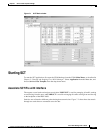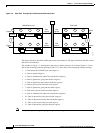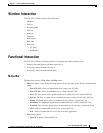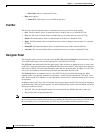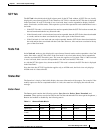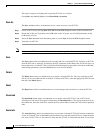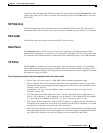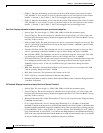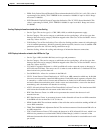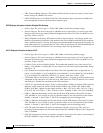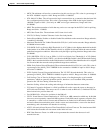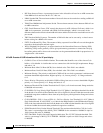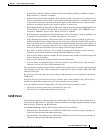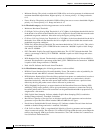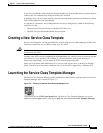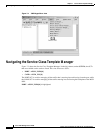
7-11
Cisco WAN Manager User’s Guide
Version 10.5, Part Number 78-12945-01 Rev. D0, August 2003
Chapter 7 Service Class Template Manager
Functional Interaction
• EPD0: Early Packet Discard Threshold. The maximum threshold for CLP (0+1) cells. This value is
a percentage of the MAX_CELL THRESH for the connection. 1000000 is equal to 100%. Range
and value: 0-1000000.
• EFCI Threshold: Explicit Forward Congestion Indication. The VC EFCI discard threshold. This
value is a percentage of MAX_CELL THRESH. 1000000 is equal to m100%. Range and values:
0-1000000.
Scaling: Displays information related to Service Scaling
• Service Type: The service type (i.e. CBR, VBR, ABR) to which the parameters apply.
• Service Category: The service category to which the service type belongs. All service types that
belong to the same service category should be mapped to the same Class of Service Buffer. Access:
read only. Values: 0-65535.
• COS Scaling: Class of Service Scaling: Class of Service Scaling provides a means of scaling through
a set of extended parameters, which are generally platform specific, based on a set of standard ATM
parameters passed to the VSI slave during connection set up.
• Interface Scaling: Allows the scaling and exchange of information between connections.
ABR: Displays information related to the ABR Service Type
• Service Type: ABR (Available Bit Rate) service type and parameters.
• Service Category: The service category to which the service type belongs. All service types that
belong to the same service category should be mapped to the same Class of Service Buffer. Access:
read only. Values: 0-65535.
• CI Control: Congestion Indicator is a field in an RM-cell used to cause the source to decrease its
ACR (Allowed Cell Rate). The source sets CI =0 when it sends an RM cell. C=1indicats EFCI has
been received on a previous data cell.
• Cut-Off RM Cells: Allows for variations in the RM-cell.
• VSVD: Virtual Source/ Virtual Destination. A VSVD is an ABR connection which may be divided
into two or more separately controlled ABR segments. Each ABR control segment, except the first,
is sourced by a virtual source. Sources and destinations are linked via bi-directional connections,
and each connection termination point is both a source and a destination, a source for data that is
transmitting, and a destination for data that is receiving.
• ADTF: Allowed-cell-rate Decrease Time Factor/Initial-cell-rate Time-out. The time between RM
cells before the allowable cell rate returns to the initial cell rate.
• RDF: Rate Decrease Factor: An ABR service parameter that controls the decrease in cell
transmission rate.
• RIF: Rate Increase Factor. A percentage increase in the allowable cell rate for an ABR connection
if the BRM cells do not have the N1 or C1 bits set.
• NRM: Number RM. The maximum number of data cells that can be sent before sending an RM cell
on an ABR connection.
• TRM: Time RM/Minimal Adjustment Period. The maximum amount of time between RM cells on
an ABR connection.
• CDF: Cutoff Decrease Factor. CDF controls the decrease in ACR (Allowed Cell rate), which is an
ABR service parameter, associated with CRM (Cell Rate Margin), which is a measure of the
difference between the effective bandwidth allocation and the allocation for sustainable rate in cells
per second.



